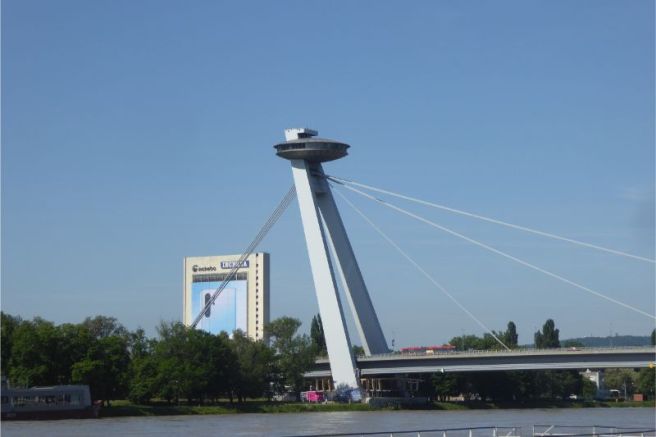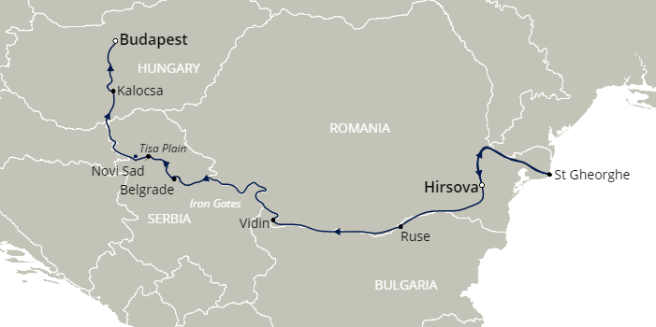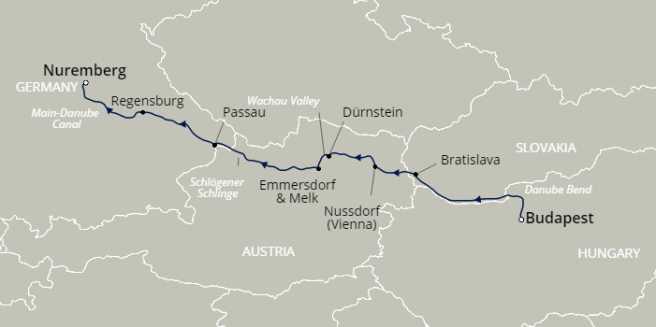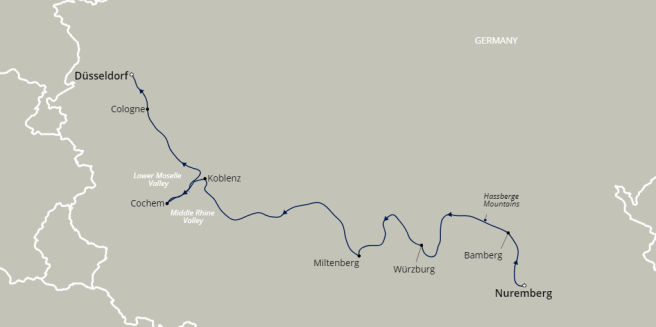In my last post, R1908 – Nearly quackers in Wachau, I described our visit to two villages in the scenic Wachau Valley in Austria. We left the second of those villages around 6pm that evening, setting sail for our next pair of ports, Passau and Regensburg, both over the border in Germany, which we would visit on consecutive days.
We were due to arrive in the first of these ports, Passau, around lunchtime the next day. Immediately after breakfast I saw that we were approaching a lock, and went up on deck to watch us transit through it. In my previous post I described how we had passed some nudists sunbathing on one of the banks of the river, and how our friend Brian’s eyes nearly popped out when he saw them. He put me on secret orders to photograph any more that I saw, but I am not sure whether the statue that I saw close to the lock entrance qualifies! There were also two more sedate ones on the opposite bank, which I also managed to snap as we passed by. The bridge across the lock was the first of a series of very low bridges that we will have to negotiate before we reach the River Rhine (but very much not the lowest), and so the sun deck fixtures and fittings had been flattened, and the wheelhouse lowered so that the ship/boat could safely pass underneath – of course passengers are banned from using the sundeck during this time. While I waited for the lock water to lift our ship/boat up to the next level, I noticed the young children watching our progress from another bridge, an unusual bicycle rack, and a large tanker lorry being lifted up on a crane and across the lock.
Our new Cruise Director, Amalia Dumitru, announced that there would be scenic cruising during the morning before we arrived in Passau, but for most of the way it was the usual tree-lined banks to watch, so it gave me another chance to catch up with writing my blog. Things got more interesting just as we approached Passau, so I put down my work and went on deck to watch our approach to the city.
Passau is also known as the City of Three Rivers as it is where the River Danube is met by the River Inn from the south and the River Ilz from the north. The old town, where we docked, is located on a narrow promontory of land between the rivers Danube and Inn. As usual on this cruise, Carol and I were not booked on a tour, instead we just wanted to explore on foot by ourselves. We set off after lunch, and at first made our way through the old town to St. Stephens Cathedral, which our port notes told us houses the world’s largest cathedral organ, with 17,974 organ pipes, 233 stops and 4 carillons. What we weren’t prepared for was just how absolutely stunning the inside of the cathedral would be. As we entered the cathedral the first thing that struck me were the wonderful paintings all over the ceilings, but very quickly I also spotted all the amazing carvings and statues. We were both completely blown away by the whole building, despite the renovation work still in progress in parts of it. It was such a contrast to the Cathedral that had disappointed us so much in Vienna a couple of days earlier.
Once we reluctantly dragged ourselves out of the Cathedral we wandered back down the main street, looking inside a number of the little shops along the way. At one point my well-trained photography assistant Carol spotted a very unusual bicycle, with integral shopping trolley! One of the shops we stopped at was a bakery, where Carol bought a slice of sacher torte, something she had hoped to have tried in Vienna. By now the thought of eating her very chocolatey cake was overwhelming Carol’s thoughts, so she decided to return to the ship/boat for a cup of tea and her cake while I carried on exploring the town on my own.
Initially I went up onto the bridge close to where our ship/boat was moored, so that I could get a view down onto the cleared sundeck. I then walked to the end of the promontory where there was a little park overlooking where the three rivers actually met.
I thought it would be interesting to continue my walk along the shoreline on the other side of the promontory to where our ship/boat was moored, but I soon found this was only just possible. We had been seeing how very high the water level in the River Danube was over the previous few days, and also how fast the water flow was and how many tree trunks, branches and other debris were being swept downstream. Here the water level was almost up to a building, and the path between it and the river was very wet and silty, meaning I had to walk very carefully along that part.
After a while I headed back inland up a steep cobbled pathway which brought me back out onto the main street. Here I walked on past the Cathedral and some more little shops until I reached a large Catholic Church, which curiously had a small road tunnel running under it. Inside the Church was completely different to the Cathedral, but still quite striking to see.
Time was ticking on by now, so I thought I had better start making my way back to the ship/boat so that I got there well before we were due to sail. I walked back along by the water towards the ship/boat, and as I passed the Rathaus (City hall) I remembered that at the port talk we were told about markings that had been painted on the wall of the building to mark the depth of various floods over the years, so paused briefly to photograph those.
Returning to the ship/boat, I rejoined Carol, and we decided to go out onto the foredeck to watch us sail away – the sundeck was still closed, but we did briefly pop up there before we actually set sail so that I could take a couple of photographs of the flattened deck. As we sailed out we could see more of the lovely pastel painted buildings and also a hotel which was intriguingly in the shape of a person lying down in bed!
We continued our voyage up the River Danube overnight, reaching our next port of call, Regensburg around 9am the following morning, where we were due to stay until around 5pm. Here there was not the usual metal landing stage to moor against, instead we were just moored against a stone quayside.
When Carol and I opened our curtains that morning we saw that the weather had changed, and that quite heavy rain was streaming down. By the time we had finished our breakfast it was still raining quite steadily, so we decided to bide our time on board in the hope that the weather would improve. Around an hour later the rain had stopped, so we decided to head out for our exploration of the old town. We walked along the riverside for a while, past several other large cruise ships/boats, before striking inland. Once again our first target was the Cathedral, and having been so blown away by the one the previous day in Passau, it was probably not surprising that we were not that impressed by this one. The main feature this time was its stained glass windows, and probably if the sun had been out and shining through the glass then we would have been more impressed.
Leaving the Cathedral we found a maze of narrow little streets, just what we love to explore. A lot of the buildings were very tall with 4, 5 or 6 floors, and they reminded me of buildings I have seen previously in various places around the Baltic.
After a while we made our way back down to the river, and I went up onto a modern footbridge to get a view downstream to the Steinerne Brücke or Old Stone Bridge. This was built in the 12th century and is Germany’s oldest arched stone bridge, and has 16 arches. I noticed that the modern bridge I was standing on had loads of padlocks attached to it, and as always I wondered how many of the couples that had faithfully attached a padlock were actually still together. We walked downstream to the Old Stone Bridge, and closeby found the Wurstkuchl, or Sausage Kitchen. This is said to be the oldest sausage kitchen in the world, built originally to feed the construction workers for both the Old Stone Bridge and the Cathedral. On the wall of the Sausage Kitchen were several marks depicting the height of floods there. Still full from my breakfast I managed to resist the temptation of trying the sausages. Instead we continued our walk downstream to where our ship/boat was moored, where we rested for the remainder of the day, and I continued to catch up with these blog posts. In the afternoon the rain set back in, so we were glad that we chose the time we did for our exploration of the city.
One feature I did notice as we walked around the old town were several examples of the old pictorial shop signs.
It was still raining intermittently when we set sail from Regensburg. Cruise ships/boats like ours are far too big to pass under the Old Stone Bridge, so instead we had to reverse downstream (I was surprised how fast) to where another part of the river went the other side of two islands before recombining to form one river once more, on the far side of the Old Stone Bridge.
From Regensburg our voyage continued via the River Danube and then the Main-Danube Canal towards our next port of call, Nuremberg, which is also in Germany. Our adventures there are likely to be the subject of my next post.
It had been interesting to compare and contrast the first two of the many stops we will be making in Germany on this extended cruise – the first with its fabulous cathedral with its huge organ, and the second with the famous and historic sausage kitchen.
Postscript
A couple of days ago we decided it was time the clothes we had been wearing so far were laundered. Unlink Fred. Olsen’s ocean cruise ships, there is not self-service laundry on board Brabant, so any laundry has to be bagged up and sent to the ship’s laundry. We were absolutely amazed when that very same evening there was a knock on our cabin door, and there was our laundry returned, all beautifully washed, pressed, and hanging on individual hangers. First class service!!














